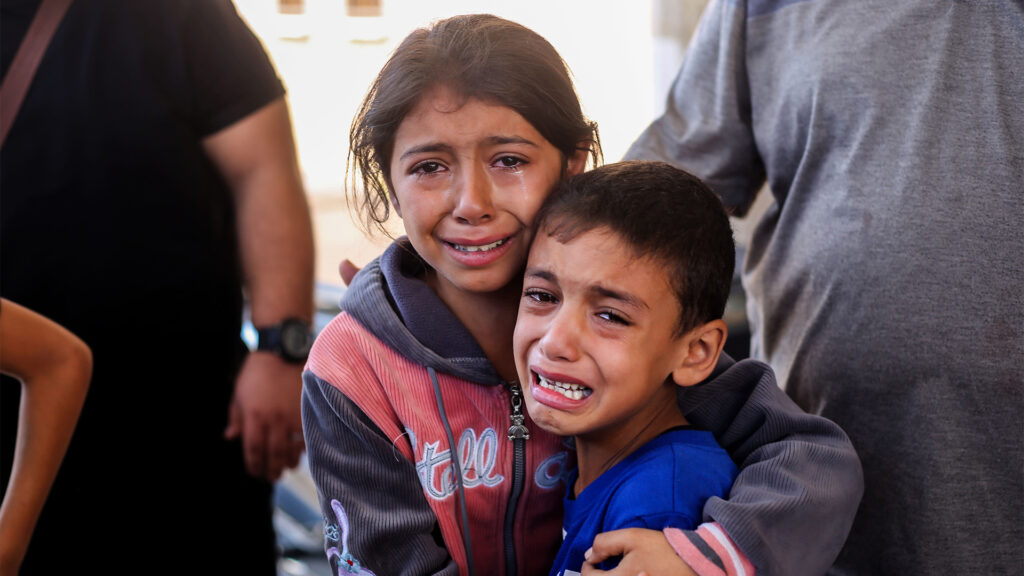Farah recalls her painful journey from the north of the Gaza Strip to the south, where her family took refuge to escape the Israeli aggression. There, from the first moment she saw the light, Farah was living in the largest open-air prison in the world.
This is how journalist Hala Al-Safadi began her article – which was published by the Middle East Eye website – to narrate the tragedy of the people of Gaza, represented by this little girl, who is 12 years old.
Al-Safadi narrates that she cannot believe that this girl, at her young age, has lived through the horrors of three Israeli wars on Gaza, and has come to know more about war than she knows about peace.
Farah follows the news and knows the names of Palestinian and Israeli politicians. She has also studied the Fourth Geneva Convention and the laws of war. Even the scenes you describe are enough to fill any child’s heart with fear and sadness, but not a heart of joy.
Today, Farah seems indifferent to the continuing horrors. This is the case for many children in Gaza for whom these scenes have become frighteningly normal.
Farah tells how their house was bombed, but she does not remember the exact date, and she no longer knows the days of the week, and all she knows is that they were in a war that has been going on for two months now.
She says that she lived near Al-Quds Hospital in the Tel Al-Hawa area of Gaza. Her father decided that everyone should go to the hospital, believing that the place would be safe.
They were initially unable to go to the south because her father could not find a place to stay, and they were afraid anyway after seeing video clips of people killed by occupation soldiers while fleeing. Some of those they knew from the north also died in the south.
Horrible experience
Farah recounts that the experience of living in the hospital was horrific, that she felt as if she was waiting for death, and that everyone there was afraid. She said that she slept with her sister (16 years old) in the upstairs corridors with the women, while her father and brother stayed on the ground floor with the men.
The night was the most terrifying time, especially when the occupation army began bombing the hospital area.
Farah says that one night, Israeli tanks began surrounding the hospital and no one was able to sleep for even a second. As soon as a young girl looked out the window, an Israeli sniper shot her and killed her, and she died in front of everyone.
Farah commented that this was the first time she had seen someone die in front of her. The mother of the martyr girl was screaming all night, and no one dared to approach the window after that. That night she cried more than ever.
Farah says they studied everything about the Palestinian Nakba in 1948. They watched films about the expulsion and killing of Palestinians. They learned of the massacres that took place in the villages. She felt that she was now living these same stories in reality.
She commented that it was sad that their story was a lesson from history. She went on to ask: Will I be like these grandmothers and tell my grandchildren how we had to flee our cities because they were killing us?
Burning cars
Farah goes on to say that they were finally allowed to leave the hospital. As the morning rose, they took Salah al-Din Street with hundreds, as the Israeli soldiers ordered them to do. They walked for a long time, from nine in the morning until two in the afternoon.
She felt that her heart would stop at any moment from fatigue. Sometimes she closed her eyes as she walked, hoping that perhaps what was happening was a dream and not reality. But she also wanted to keep her eyes open, in case soldiers shot her father or brother.
A journey of suffering
At a certain point in the journey of suffering, Israeli soldiers detained two young men, who seemed to have chosen them at random, and ordered them at gunpoint to take off their clothes, except for their underwear, and they let one of them return and took the second. They did not know what happened to him, and his family kept crying all the way. Here, Farah’s concerns about the arrest of her father or brother increased.
As if this suffering was not enough, Israel set up security checkpoints and ordered everyone to pass through a detection device that uses facial scanning technology. I was afraid that one of them would be shot, as two soldiers tried to provoke them by saying, “Thank us and thank Hamas for that.” But people kept urging each other to ignore their screams in order to reach safety.
Farah continued that the more they walked, the more corpses they saw on the road. She saw a woman lying next to a small child. Some of the bodies were covered with blankets. There were also burned cars with burned bodies inside.
As soon as they set foot in Wadi Gaza, dozens of Palestinians were waiting for them and told them that they were now safe. They gave them juices and chocolate cakes.
Farah sat on the ground and was unable to move for a while. She hugged her father a lot and started crying. Her father told her she had to be strong, so she got up and walked until she reached a United Nations school.

